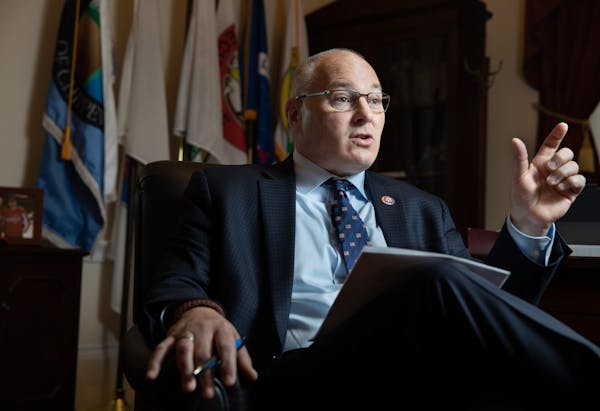Talon Metals took a major step Wednesday toward opening an underground nickel mine in northern Minnesota, submitting a plan to the state that will trigger a new discussion over the risks and benefits of hardrock mining.
The company, based in the British Virgin Islands and run from Canada, has stressed the need for minerals to speed the transition away from fossil fuels. Talon signed a memorandum of understanding last year to supply roughly half the nickel it produces to Tesla for electric vehicle batteries.
The details of this preliminary mine proposal will come under heavy scrutiny for the potential to harm the environment. Those concerns have stalled two copper-nickel mines proposed by other companies in northern Minnesota.
The plan laid out by Talon in its submission Wednesday "is not definitive," said Todd Malan, chief external affairs officer for the company. "We have room to make improvements or changes based on feedback."
Located 50 miles west of Duluth, Talon's Tamarack Mine in Tamarack, Minn., would include a 60-acre campus on the surface, a roughly 1.5 mile rail spur to a nearby train line, and a far more extensive underground mine to extract nickel and other metals hundreds of feet below, executives of the company said in an interview.
A boring machine — like those used to carve out subway tunnels — would dig a loop near the surface to ferry trucks in and out of the mine. Workers would drill and blast underground to reach nickel, copper, iron and platinum-group metals encased in bedrock. The highest-grade minerals sit between 1,500 and 2,000 feet deep. The shallowest planned mining would happen at 300 feet.
The submission starts what will likely be years of review and permitting, beginning the "scoping" in which the Department of Natural Resources will take input from the public on what to study when it prepares a deeper environmental review in the coming months.
"I want to assure all Minnesotans that the DNR is committed to a rigorous, transparent, and neutral review of the project, based on science and applicable state law," Katie Smith, director of the DNR's Ecological and Water Resources Division, said in a prepared statement.
One group keenly interested in Talon's plans is the Mille Lacs Band of Ojibwe. The tribe has said it will closely monitor the project for potential damage to wild rice and other natural resources.
"There is much at stake; the proposed mine would be located just 1.3 miles from our communities and has the potential to impact our forever home and critical environmental and cultural resources," Mille Lacs Chief Executive Melanie Benjamin wrote in a prepared statement Wednesday.
Hardrock mining is still new to Minnesota, and carries different risks than the iron and taconite mining that has long been conducted here. Among those risks, the underground sulfides that contain nickel, when broken apart, can react with air or water to create acid mine drainage.
Talon will transport the material it digs out to a processing site in North Dakota with the help of a $114 million federal grant, removing one potential source of pollution. The details of how it ships material there and handles the rock that doesn't contain enough metal to process will be crucial for controlling pollution.
Still, the fact that there is no permanent waste rock storage proposed now for Minnesota "may take away some complication" in the environmental review process, Jess Richards, a DNR assistant commissioner, said in a phone call with reporters.
Richards said the scoping process usually takes about a year, and the public will have the opportunity to offer comment toward the end of that period. Before that, the DNR will likely ask Talon for more information on its plan.
Under its rough proposal, at least some rock containing sulfides will be hauled to the surface and staged there, instead of being shipped immediately west. This "development rock," mostly bedrock that doesn't contain significant nickel or other profitable metals, will be stacked on lined pads before it is mixed into cement and trucked back below ground, to backfill the mine.
Talon's submission says it will use best practices to manage dust and runoff where it stores these rocks. The details of plans to control dust and other potential pollution would not be finalized until permitting, potentially years into the future.
Talon has 51% ownership in the proposed mine, which it would operate. The remaining 49% is owned by Kennecott, a subsidiary of the London-based international mining conglomerate Rio Tinto. Talon has the option to increase its ownership to 60% if it meets certain project goals and makes a $10 million payment to Kennecott.
Talon proposes to start construction on the mine site in 2026. It would begin extracting materials in 2027, producing a maximum of 800,000 tons of ore per year, and operate between seven and 10 years.
Paula Maccabee, an attorney for the group Water Legacy who has challenged several aspects of the NorthMet copper-nickel mine proposal in northeast Minnesota, said Talon's document lacked detail about potential threats to water quality.
As for completing review and getting the permits to start construction by 2026, "There's no scientifically rigorous way to do that," Maccabee said.
Two other copper-nickel projects in Minnesota have yet to start.
Twin Metals' proposed mine near Ely no longer has mineral leases, after they were canceled by the Biden administration. The NorthMet mine originally proposed by PolyMet would operate near Babbitt and process material near Hoyt Lakes, but three necessary permits are in legal limbo, and a fourth was recently revoked over threats to water quality.
Brooklyn Park police make arrest after asking for help in search for man suspected of sexual assault at gunpoint

Attorney Tayler Rahm wins GOP backing in battleground Second District
North Oaks withdraws request for density exemption from Met Council

